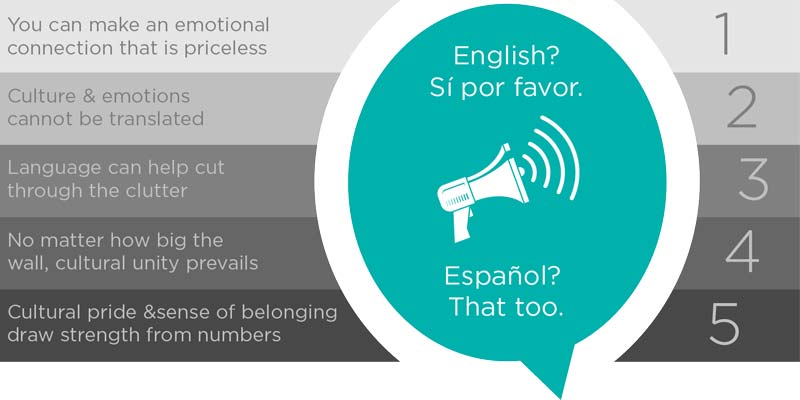
Marketing to Hispanics: English? Si por favor. Espanol? That too.
Filed Under: Best Practices, Market Research, Hispanic / Latino, Advertising Testing
Jorge Martínez-Bonilla
Senior Vice President, CultureBeat
Our pockets would be really heavy if we had a dollar for every time we’re asked the question, “Should my client market to their Hispanic consumers in English or Spanish?” Ok, we would still need our jobs, but this frequent dilemma really paints the picture of today’s market.
Every year, our clients face the challenge of driving growth within the Hispanic segment, while balancing advertising budgets – particularly whether their messaging should be in English or Spanish, or both. Because of the growth of the Hispanic segment, specifically the bicultural segment, companies are tempted to assume “English is enough” when it comes to advertising.
The PEW Research Center published a report that addresses the evolution of the U.S. Hispanic landscape. According to the report:
- About one in every three U.S. Hispanic consumers is younger than 18;
- Nearly half of the U.S.-born Latinos are younger than 18;
- Three-quarters of Hispanic Millennials are proficient English speakers, and more than a quarter speak only English at home.
So the advertising language dilemma is easily resolved, right? If you are a marketer, you’re probably thinking, “I don’t have to spend our money in Spanish advertising anymore.” Well, chances are that while tempting, that strategy could end up hurting your brand’s growth.
We, at C+R, believe that for you as a marketer, the Spanish language in advertising is still important, very important; and we’re here to help you understand why.

Here are 5 reasons why you should still consider reaching out to Hispanics en Espanol:
1. You can make an emotional connection that is priceless: Every single time we interview Hispanics (of any acculturation level), you can just feel a certain pride and nostalgia in the room. There’s this vitality and feeling of camaraderie that comes to life not only through their voiced opinions, but also through the unstated common understanding of certain things. It is all too common to hear a Hispanic focus group participant say “you know how we Hispanics are,” or “you know how we Latina mothers feel.” And the thing is, we as Hispanic descendants do know what they mean!
That understanding is often what makes or breaks a marketing and communications strategy. A few years ago, when we asked Hispanics how they felt about culture and language, 95% of them stated they believe it is “very important for future generations of Hispanics in the U.S. to be able to speak Spanish.” It is no surprise that one of Coca-Cola’s latest campaigns touches on that emotional connection.
2. Culture and emotions cannot be translated. Try to translate “umpf,” or tell a Hispanic (in Spanish) that you’ll buy them an “elephant ear” next time you go to the county fair. When it comes to culture and emotion, some things simply don’t translate. That’s why when crafting a message, to make it impactful, focusing on the meaning is far more important than focusing on the words. If you leave those “untranslatable” messages in English, you could potentially miss out on the still rather large segment of Hispanics who prefer Spanish. That’s why as marketers, it’s important to explore the need of Spanish communications when planning your strategy.
3. Language can help cut through the clutter.Imagine yourself at your favorite sports team opening home game, all the noise, all the voices and suddenly you hear someone shout, “Hey, you!”. Would you turn your head and check if it was for you? Maybe, maybe not. Alternatively, if the shout was, “Hey, Charly!” and you are a Charly, would you turn and look now? Chances are you would. Similarly, while in the midst of all the media bombardment, when Hispanics hear a message in Spanish, they are more likely to turn their heads, even if they are not Neruda’s most avid reader. In fact, a recent study by NBCUniversal’s Culture First found that “81% of Hispanics say they don’t need to be fluent in Spanish for Spanish advertising to speak to them.” Simply stated, for Hispanics, the Spanish language is recognized as a cultural signal that is relevant to them, whether they speak it regularly or not.
4.No matter how big the wall, cultural unity prevails.You’ve heard about Trump’s wall, right? While we don’t endorse illegal immigration, we are realistic and know that what drives Hispanics to leave their homes is the search for a brighter future. Regardless of walls, Hispanics will continue to come into this country. Sure, maybe it won’t be in large waves, but the flow will continue. In fact, Reuters reports a rush on migration along the U.S.-Mexico border as a result of the ongoing anti-immigration narrative. The ongoing immigration of U.S. Hispanics will likely yield a new wave of consumers that are still culturally and emotionally attached to their roots, and language plays a pivotal role in keeping them connected to their cultural DNA.
5. Cultural pride and sense of belonging draw strength from numbers. Growing up, I used to fight with my brothers; that’s what brothers do. But as soon as any random kid tried to mess with my brothers, I was the first one to jump in and protect my own (sadly, most times I ended up drawing the short stick!). Something similar happens with Hispanics: you mess with one, you mess with all. True, there are many Hispanics who actually side with anti-immigration initiatives, but most are fueled precisely by that sense of belonging to a culture that is their own, that makes and shapes who and how they are. That’s why, as the NYT reports, many have rushed to seek naturalization. Spanish, naturally, is one of the dimensions of culture.
So, the next time you are tasked with designing a strategy that includes Hispanics as a target, make sure you do not fall prey to the temptation of ignoring the Spanish language as a worthy tactic in your strategy.
explore featured
Case studies

